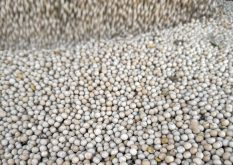SASKATOON — Russia’s wheat exports have been sluggish so far in the 2025-26 campaign, but analysts anticipate the pace will pick up as the year unfolds.
The country exported 11 million tonnes in the July through September period, the poorest start to the season since 2017-18 except for 2022-23, when trade was disrupted by the start of the Ukraine war, according to SovEcon.
SovEcon estimates Russian farmers harvested 87.2 million tonnes of wheat, up from 82.6 million tonnes last year.
Read Also

Rising vegetable oil demand may offset bad biofuel news
Global biodiesel/renewable diesel production is expected to decline for the first time in a decade. Bad timing for a canola industry looking for new markets.
Exports for 2025-26 are forecast at 43.4 million tonnes, up from 40.8 million tonnes.
Russia will have to make up for the slow start if it is to ship out an extra 2.6 million tonnes of wheat this crop year.
SovEcon analyst Andrey Sizov said shipments are already picking up steam due to rising demand.
Black Sea f.o.b. values have been trending higher in recent weeks, he said in an email.
Sizov is forecasting a further acceleration in exports in October. SovEcon’s first estimate for the month is 4.7 to 5.2 million tonnes, compared to 5.6 million tonnes a year ago and an average of 4.5 million tonnes.
However, weather and infrastructure bottlenecks will become a bigger issue from late-October until March.
There will be more frequent storms in the Black Sea, shutdown of river navigation in late-October and November and potential freezing of the Sea of Azov.
Western Producer Markets Desk analyst Bruce Burnett said the looming increase in the pace of Russian wheat exports is one of the main reasons the long-term outlook for wheat is bearish.
He is not forecasting a sudden tsunami of Russian wheat, but there will be an increase in the pace of the country’s export program, and it will likely last longer than normal.
Instead of tapering off in May-April, it could continue almost into the new crop year.
Sizov disagrees. He said Russian exports do not typically slow down in April-May. In fact, they tend to pick up after March.
He does not think Russia’s export program is weighing down global wheat prices as much as the prospect of bumper crops coming from Argentina and Australia, which could put further pressure on prices during the second half of 2025-26.
However, even with those good Southern Hemisphere crops on the way, the stocks-to-use ratio for major exporters will be at historically low levels.
That does not justify the nearby futures contract for Chicago wheat testing US$5 per bushel, said Sizov.
Burnett said the one piece of good news for North American farmers is that Canada and the United States have picked up some Asian business because of Russia’s diminished presence in that market.
He does not understand why Russia’s exports were so lacklustre during the first quarter of 2025-26.
“They’ve had some difficult logistics on the wheat side, and it’s a bit puzzling to me why,” said Burnett.
Dennis Voznesenski, agricultural economist with the Commonwealth Bank of Australia, said the slow pace of vessel movement in and out of the Sea of Azov are partially to blame.
“Vessels entering/exiting the Sea of Azov have been undergoing extra scrutiny to ensure no damage is done to the Kerch Bridge, which connects mainland Russia to Crimea,” he said in his recent Agri Commodity Weekly Alert report.
Other causes for the poor start are the weather challenges that slowed harvest in Russia’s southern cropping regions and restrained farmer selling due to poor prices, said Voznesenski.
Sizov believes it had more to do with weak early-season wheat demand, depressed export prices, the relatively strong Russian ruble and the poor crop of wheat in the south of Russia, which is the major exporting region.
















